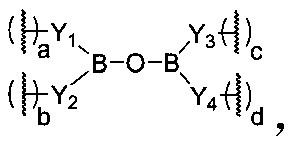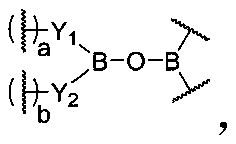Combined energy absorption method and application thereof
A polymer, dynamic covalent bond technology used in the field of combined energy absorption
- Summary
- Abstract
- Description
- Claims
- Application Information
AI Technical Summary
Problems solved by technology
Method used
Image
Examples
preparation example Construction
[0643] In the preparation process of dynamic polymer foam materials, three methods of mechanical foaming, physical foaming and chemical foaming are mainly used to foam dynamic polymers.
[0644] Among them, the mechanical foaming method is to introduce a large amount of air or other gases into the emulsion, suspension or solution of the polymer with the help of strong stirring during the preparation of the dynamic polymer to make it a uniform foam, and then through physical Or chemical changes make it shape and become a foam material. In order to shorten the molding cycle, air can be introduced and emulsifiers or surfactants can be added.
[0645] Wherein, the physical foaming method is to use physical principles to realize the foaming of the polymer during the preparation of the dynamic polymer, which includes but not limited to the following methods: (1) inert gas foaming method, that is, after adding Press the inert gas into the molten polymer or pasty material under high ...
Embodiment 1
[0666] Using 1,6-hexamethylene diisocyanate and furan methanol as raw materials, dichloromethane as solvent, and stannous octoate as catalyst, control the molar ratio of the two to 1:2, react at room temperature for 2 hours under nitrogen protection, and reflux After reacting for 2h, the difuran compound (a) was obtained. Quantitative diphenylmethane diisocyanate and polyoxypropylene diol PPG-700 are reacted to make isocyanate-terminated polyether.
[0667] Weigh a certain amount of dichloromethane solvent in a dry and clean flask, add 8mmol N-hydroxymaleimide and 4mmol 8-hydroxybenzo[a]pyrene, mix well, heat to 100°C and blow nitrogen to remove water and oxygen for 1h , then slowly add 7mmol of isocyanate-terminated polyether, react at 80°C for 2h under nitrogen protection, then cool down to 60°C, add 4mmol of difuran compound (a), 5wt% silicon dioxide, 5wt% barium sulfate, 0.02wt% Sodium dodecylbenzenesulfonate, 0.02wt% bentonite, continue to stir and react for 1 hour to ob...
Embodiment 2
[0669] Using vinyl boronic acid and hydrogen-terminated silicone oil with a viscosity of about 3,000mPa·s as raw materials, the boric acid-terminated silicone oil is obtained by hydrosilylation under the catalysis of platinum olefin complex Pt(dvs). Using 4-methyl-4-pentenoic acid and hydrogen-terminated silicone oil with a viscosity of about 3,000mPa·s as the raw material, the carboxylic acid sealant was prepared by hydrosilylation under the catalysis conditions of the platinum ene complex Pt(dvs). end silicone oil.
[0670] Using amino-terminated silicone oil with a viscosity of about 2,000mPa·s as a raw material, the reaction is carried out in the presence of an equimolar equivalent catalyst, triethyl orthoacetate, to obtain amidinyl-terminated silicone oil.
[0671] Add 0.02mol of boric acid-terminated silicone oil, 0.02mol of diglyceryl ether, 0.02mol of amidinyl-terminated silicone oil, 0.02mol of carboxylic acid-terminated silicone oil into a dry and clean three-necked ...
PUM
| Property | Measurement | Unit |
|---|---|---|
| Viscosity | aaaaa | aaaaa |
| Viscosity | aaaaa | aaaaa |
| Apparent viscosity | aaaaa | aaaaa |
Abstract
Description
Claims
Application Information
 Login to View More
Login to View More - Generate Ideas
- Intellectual Property
- Life Sciences
- Materials
- Tech Scout
- Unparalleled Data Quality
- Higher Quality Content
- 60% Fewer Hallucinations
Browse by: Latest US Patents, China's latest patents, Technical Efficacy Thesaurus, Application Domain, Technology Topic, Popular Technical Reports.
© 2025 PatSnap. All rights reserved.Legal|Privacy policy|Modern Slavery Act Transparency Statement|Sitemap|About US| Contact US: help@patsnap.com



